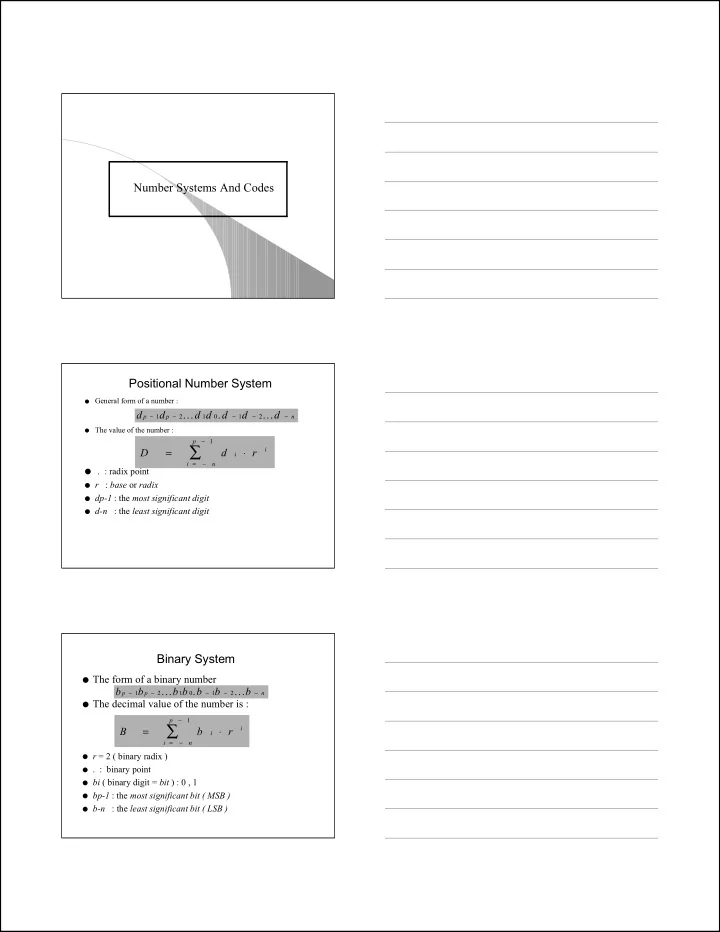

Number Systems And Codes Positional Number System ● General form of a number : d d ... d d . d d ... d p − 1 p − 2 1 0 − 1 − 2 − n ● The value of the number : − p 1 ∑ i D = d ⋅ r i = − i n ● . : radix point ● r : base or radix ● dp-1 : the most significant digit ● d-n : the least significant digit Binary System ● The form of a binary number b b ... b b . b b ... b − − − − − p 1 p 2 1 0 1 2 n ● The decimal value of the number is : − p 1 ∑ i B = b ⋅ r i i = − n ● r = 2 ( binary radix ) ● . : binary point ● bi ( binary digit = bit ) : 0 , 1 ● bp-1 : the most significant bit ( MSB ) ● b-n : the least significant bit ( LSB )
Binary,Decimal,Octal and Hexadecimal Numbers Decimal Binary Octal Hexadecimal 0 0 0 0 1 1 1 1 2 10 2 2 3 11 3 3 4 100 4 4 5 101 5 5 6 110 6 6 7 111 7 7 8 1000 10 8 9 1001 11 9 10 1010 12 A 11 1011 13 B 12 1100 14 C 13 1101 15 D 14 1110 16 E 15 1111 17 F General Positional Number Conversion ● radix-r to decimal : p − 1 ∑ = ⋅ i D d r i i = − n ● decimal to radix-r : - Successive division of D by r - The remainder of the long divsion will give the digits starting from the least significant digit Binary Addition ● Binary addition table : carry(in) x y x+y carry(out) 0 0 0 0 0 0 0 1 1 0 0 1 0 1 0 0 1 1 0 1 1 0 0 1 0 1 0 1 0 1 1 1 0 0 1 1 1 1 1 1
Binary Subtraction ● Binary Subtraction table : borrow(in) x y x-y borrow(out) 0 0 0 0 0 0 0 1 1 1 0 1 0 1 0 0 1 1 0 0 1 0 0 1 1 1 0 1 0 1 1 1 0 0 0 1 1 1 1 1 Two’s Complement Representation ● The MSB represents the sign bit ( 0 = +ve , 1 = -ve ) ● To calculate the negative number : 1- Complement all bits of the positive number ( one’s complement) 2- Add 1 ● For n-bit number the decimal value = n − 2 ∑ i n − 1 B = b ⋅ 2 − b ⋅ 2 i n − 1 i = 0 ● The range for n-bit is : − ( 2 n − 1 ) + ( 2 n − 1 − 1 ) from to ● Advantages : 1- Only one zero 2- Addition and subtraction can be performed directly ● Disadvantage : One extra negative number ( not symmetric ) Comparison ( n=4 ) Decimal Signed Magnitude One’s Complement Two’s Complement -8 - - 1000 -7 1111 1000 1001 -6 1110 1001 1010 -5 1101 1010 1011 -4 1100 1011 1100 -3 1011 1100 1101 -2 1010 1101 1110 -1 1001 1110 1111 0 0000 or 1000 0000 or 1111 0000 1 0001 0001 0001 2 0010 0010 0010 3 0011 0011 0011 4 0100 0100 0100 5 0101 0101 0101 6 0110 0110 0110 7 0111 0111 0111
Decimal Codes ( Table ) Decimal BCD(8421) 2421 Excess-3 Biquinary 1-out-of-10 0 0000 0000 0011 0100001 1000000000 1 0001 0001 0100 0100010 0100000000 2 0010 0010 0101 0100100 0010000000 3 0011 0011 0110 0101000 0001000000 4 0100 0100 0111 0110000 0000100000 5 0101 1011 1000 1000001 0000010000 6 0110 1100 1001 1000010 0000001000 7 0111 1101 1010 1000100 0000000100 8 1000 1110 1011 1001000 0000000010 9 1001 1111 1100 1010000 0000000001 Gray Code ● One bit changes between two successive code words ● Binary Code and Gray Code ( n = 3 ) : Decimal Binary Code Gray Code 0 000 000 1 001 001 2 010 011 3 011 010 4 100 110 5 101 111 6 110 101 7 111 100 ASCII Table ● b6b5b4 000 001 010 011 100 101 110 111 b3b2b1b0 0000 SP 0 @ ‘ 0001 ! 1 A a 0010 “ 2 B b 0011 # 3 C c 1111 ● The Code for a is 1100001
Recommend
More recommend